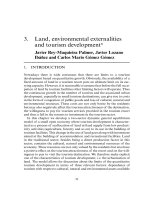THE ECONOMICS OF MONEY,BANKING, AND FINANCIAL MARKETS 468
Bạn đang xem bản rút gọn của tài liệu. Xem và tải ngay bản đầy đủ của tài liệu tại đây (46.7 KB, 1 trang )
436
PA R T V
The Bank of
Canada s
Standing
Facilities
Central Banking and the Conduct of Monetary Policy
At the end of each banking day, each LVTS participant must bring its settlement
balance with the Bank of Canada close to zero. Of course, it can scarcely be
expected that LVTS participants will always be successful in ending up with nearzero settlement balances. The Bank of Canada therefore stands ready (with what
we call standing liquidity facilities) to lend to or borrow from a participant to
bring their settlement balances to zero at the end of the banking day. As already
noted, participants also know with certainty the rates applicable to positive
and negative settlement balances with the Bank of Canada (see the FYI box,
Monetary Policy Implementation in the LVTS Environment, and Figure 17-1).
To permit participating financial institutions to adjust positions with each
other (i.e., reduce the costs of either positive or negative positions), the LVTS has
a pre-settlement trading period of half an hour, at the end of the banking day
(6 6:30 p.m.). The purpose of the pre-settlement trading period is to allow LVTS
participants to reduce their LVTS positions (which resulted during the day from
their own transactions and those of their clients) at interest rates better than those
at the Bank of Canada s standing liquidity facilities. That is, to provide a window
for those participants with excess positions to trade with those in deficit, at a better return than can be achieved at the Bank s facilities, to the advantage of both.
In fact, the typical bid ask spread on overnight funds in the interbank market has
been less than 1/8%. This is significantly less than the spread of 50 basis points
between the rate charged on overdrafts and that paid on deposits by the Bank of
Canada after settlement of LVTS multilateral positions.
In general, pre-settlement trading among participants will achieve a zero settlement balance for each participant on wholesale transactions. However, if at the end
of the settlement day a participant has a negative balance on the books of the Bank
The Worldwide Decline in Reserve Requirements and
the Channel/Corridor System for Setting Interest Rates
FYI
As already noted, central banks in many
countries have been reducing or eliminating
their reserve requirements. For example,
there are no reserve requirements in
Australia, Canada, New Zealand, Switzerland,
and the U.K., while in the euro area the
reserve ratio is 2% and in the U.S. 3%, rising
to 10% for large deposit holdings. The fall in
reserve requirements has elicited the concern that if the demand for reserves falls to
zero, then a central bank may not be able to
exercise control over interest rates.
However, the so-called channel or corridor system for conducting monetary policy
which has been adopted by Canada,
Australia, and New Zealand shows that
5
central banks can continue to effectively set
overnight, interbank interest rates like the
overnight interest rate in Canada. How the
channel/corridor system works is discussed
in detail in this chapter.5
The important point of this analysis is that
the channel/corridor approach enables the
central bank to set the overnight policy rate
whatever the demand for reserves, including
zero demand. Thus in the future, continuing
declines in the demand for reserves may
eventually lead central banks to follow in the
footsteps of the central banks of Canada,
Australia, and New Zealand and to adopt the
channel /corridor system for conducting monetary policy.
See also Michael Woodford, Monetary Policy in the Information Economy, in Symposium on
Economic Policy for the Information Economy (Federal Reserve Bank of Kansas City: 2001).









